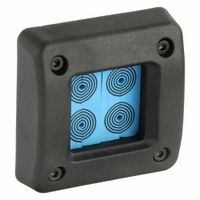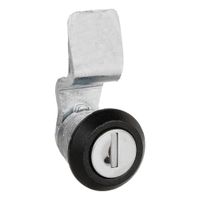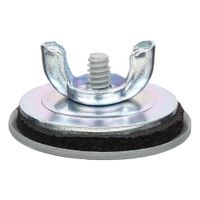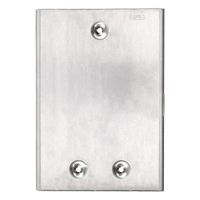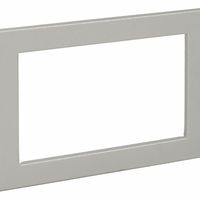Call +(254) 703 030 000 / 751 483 999 / 721 704 777
- Home
- Electrical
- Electrical Boxes Enclosures
- Electrical Enclosures Accessories
- Accessories For Electrical Enclosures
.....Read More
Frequently Asked Questions
What are the essential accessories for electrical enclosures?
Essential accessories for electrical enclosures include:
1. **Cable Glands**: These provide secure entry points for cables, ensuring a tight seal to prevent dust, moisture, and other contaminants from entering the enclosure.
2. **Mounting Plates**: Used to mount electrical components securely within the enclosure, offering a stable platform for organizing and supporting equipment.
3. **Cooling Systems**: Fans, vents, and air conditioners help regulate temperature, preventing overheating of components inside the enclosure.
4. **Gaskets and Seals**: These ensure the enclosure is weatherproof and dustproof, maintaining the integrity of the internal environment.
5. **Locks and Latches**: Provide security and controlled access to the enclosure, protecting sensitive equipment from unauthorized access.
6. **DIN Rails**: Standardized mounting rails for securing terminal blocks and other modular components, facilitating easy installation and maintenance.
7. **Lighting**: Internal lighting solutions improve visibility inside the enclosure, aiding in maintenance and inspection tasks.
8. **Heaters**: Prevent condensation and maintain optimal temperature in cold environments, protecting sensitive electronics.
9. **Hinges and Handles**: Facilitate easy opening and closing of the enclosure doors, enhancing accessibility for maintenance.
10. **Filters**: Used in conjunction with fans to prevent dust and debris from entering the enclosure while allowing airflow.
11. **Surge Protectors**: Protect internal components from voltage spikes and electrical surges, ensuring longevity and reliability.
12. **Labeling Systems**: Enable clear identification of components and wiring, aiding in organization and troubleshooting.
13. **Grounding Kits**: Ensure proper grounding of the enclosure and its components, enhancing safety and reducing electrical noise.
14. **Panel Cutouts and Knockouts**: Allow for easy customization and expansion, accommodating additional components or cable entries as needed.
How do interior mounting panels benefit electrical enclosures?
Interior mounting panels benefit electrical enclosures by providing a structured and organized platform for mounting electrical components, which enhances safety, efficiency, and maintenance. They allow for optimal space utilization within the enclosure, ensuring that components such as circuit breakers, relays, and terminal blocks are securely fastened and easily accessible. This organization reduces the risk of short circuits and electrical faults by preventing components from coming into contact with each other or the enclosure walls.
Mounting panels also facilitate better heat dissipation by allowing air to circulate around the components, which helps in maintaining optimal operating temperatures and prolonging the lifespan of the equipment. They enable easy customization and scalability, as additional components can be added or rearranged without significant modifications to the enclosure itself.
Furthermore, interior mounting panels simplify maintenance and troubleshooting. Technicians can quickly identify and access components, reducing downtime and improving repair efficiency. This organized layout also aids in compliance with industry standards and regulations, as it ensures that components are installed in a manner that meets safety and operational guidelines.
In summary, interior mounting panels enhance the functionality, safety, and efficiency of electrical enclosures by providing a systematic approach to component installation and management.
What is the purpose of hole seals in electrical enclosures?
The purpose of hole seals in electrical enclosures is to maintain the integrity and safety of the enclosure by sealing unused openings. These seals serve several critical functions:
1. **Protection Against Environmental Factors**: Hole seals prevent the ingress of dust, dirt, moisture, and other environmental contaminants that could compromise the electrical components inside the enclosure. This is crucial for maintaining the reliability and longevity of the equipment.
2. **Safety**: By sealing unused holes, hole seals help prevent accidental contact with live electrical parts, reducing the risk of electrical shock to personnel. They also help in maintaining the enclosure's fire resistance by preventing the spread of flames through open holes.
3. **Maintaining Enclosure Ratings**: Electrical enclosures often have specific ratings, such as NEMA or IP ratings, which indicate their ability to withstand certain environmental conditions. Hole seals ensure that these ratings are not compromised by open holes, thus maintaining the enclosure's specified level of protection.
4. **Pest Prevention**: Sealing holes deters insects and small animals from entering the enclosure, which could cause damage or create short circuits.
5. **Aesthetic and Structural Integrity**: Hole seals provide a finished appearance to the enclosure, contributing to its overall aesthetic. They also help maintain the structural integrity of the enclosure by reinforcing areas that might otherwise be weak points due to open holes.
6. **Pressure Equalization**: In some cases, hole seals are designed to allow for pressure equalization within the enclosure, preventing condensation and ensuring optimal operating conditions for the electrical components.
Overall, hole seals are essential for ensuring the safe, efficient, and reliable operation of electrical enclosures in various environments.
How do cable and pipe seals enhance the safety of electrical enclosures?
Cable and pipe seals enhance the safety of electrical enclosures by providing several critical functions:
1. **Environmental Protection**: They prevent the ingress of dust, water, and other contaminants, maintaining the integrity of the enclosure's internal environment. This is crucial for preventing short circuits and corrosion, which can lead to equipment failure or fire hazards.
2. **Fire Safety**: Seals are often made from fire-resistant materials that can withstand high temperatures, preventing the spread of fire through cable and pipe entries. This containment is vital in minimizing damage and providing time for fire suppression systems to activate.
3. **Pressure Sealing**: In environments where pressure differentials exist, seals maintain the necessary pressure levels within the enclosure, ensuring that equipment operates under optimal conditions and preventing the entry of explosive gases.
4. **Mechanical Protection**: They provide strain relief and mechanical support to cables and pipes, reducing the risk of damage from vibrations, pulling, or bending. This protection extends the lifespan of the cables and prevents accidental disconnections or breaks.
5. **EMI/RFI Shielding**: Seals can also offer electromagnetic interference (EMI) and radio-frequency interference (RFI) shielding, protecting sensitive electronic components from external electromagnetic fields that could disrupt operations.
6. **Compliance and Standards**: Using appropriate seals ensures compliance with industry standards and regulations, which is essential for safety certifications and legal requirements.
7. **Cost Efficiency**: By preventing damage and reducing maintenance needs, seals contribute to lower operational costs and increased reliability of the electrical systems.
Overall, cable and pipe seals are integral to maintaining the safety, reliability, and efficiency of electrical enclosures in various industrial and commercial applications.
What are the advantages of using window kits in electrical enclosures?
Window kits in electrical enclosures offer several advantages:
1. **Visibility**: They allow operators to visually inspect the equipment without opening the enclosure, reducing the risk of exposure to hazardous voltages and improving safety.
2. **Safety**: By minimizing the need to open enclosures, window kits help maintain the integrity of the enclosure's protective features, such as dust and water resistance, and reduce the risk of accidental contact with live components.
3. **Efficiency**: Quick visual checks through window kits can speed up routine inspections and troubleshooting, leading to reduced downtime and maintenance costs.
4. **Protection**: They help maintain environmental protection ratings (e.g., NEMA, IP) by reducing the frequency of opening the enclosure, which can compromise seals and gaskets.
5. **Cost-Effectiveness**: By reducing the need for frequent opening and closing, window kits can extend the lifespan of the enclosure and its components, leading to cost savings over time.
6. **Compliance**: Window kits can assist in meeting regulatory and safety standards by providing a means to monitor equipment status without compromising safety protocols.
7. **Customization**: Available in various sizes and materials, window kits can be tailored to specific applications, ensuring compatibility with different types of enclosures and environmental conditions.
8. **Convenience**: They provide a convenient way to monitor indicators, displays, and control panels, facilitating easier management of electrical systems.
9. **Aesthetic Appeal**: Window kits can enhance the appearance of enclosures by providing a clean and professional look, which can be important in settings where aesthetics matter.
10. **Versatility**: Suitable for a wide range of applications, from industrial to commercial settings, window kits offer flexibility in use across different sectors.
How can electrical enclosure accessories improve security and performance?
Electrical enclosure accessories enhance security and performance in several ways:
1. **Enhanced Protection**: Accessories like gaskets and seals ensure that enclosures are watertight and dustproof, protecting sensitive components from environmental hazards. This prevents damage and extends the lifespan of the equipment.
2. **Improved Access Control**: Locking mechanisms and security latches restrict unauthorized access, safeguarding against tampering and theft. This is crucial in environments where sensitive or critical electrical systems are housed.
3. **Thermal Management**: Accessories such as fans, vents, and heat exchangers help regulate temperature within the enclosure. Proper thermal management prevents overheating, ensuring optimal performance and reducing the risk of component failure.
4. **Cable Management**: Cable glands and entry systems organize and secure cables, reducing clutter and minimizing the risk of electrical shorts or interference. This improves system reliability and simplifies maintenance.
5. **Vibration and Shock Resistance**: Mounting accessories and shock absorbers protect internal components from mechanical stress, enhancing durability and performance in high-vibration environments.
6. **EMI/RFI Shielding**: Accessories that provide electromagnetic interference (EMI) and radio-frequency interference (RFI) shielding protect sensitive electronics from external noise, ensuring signal integrity and reliable operation.
7. **Customization and Scalability**: Modular accessories allow for easy customization and expansion of enclosures, accommodating future upgrades and changes without compromising security or performance.
8. **Compliance and Standards**: Accessories that meet industry standards and certifications ensure that enclosures comply with safety and performance regulations, reducing liability and ensuring safe operation.
By integrating these accessories, electrical enclosures can offer robust protection, maintain optimal operating conditions, and ensure the security and efficiency of the housed equipment.
What are the best practices for maintaining and replacing electrical enclosure parts?
1. **Regular Inspection**: Conduct routine inspections to identify signs of wear, corrosion, or damage. Check for loose connections, moisture ingress, and any physical damage to the enclosure.
2. **Cleaning**: Keep enclosures clean from dust, dirt, and debris. Use appropriate cleaning agents that do not damage the enclosure material or compromise its protective features.
3. **Environmental Considerations**: Ensure enclosures are suitable for their environment. Use weatherproof or corrosion-resistant materials in harsh conditions. Maintain seals and gaskets to prevent moisture and dust ingress.
4. **Temperature Management**: Monitor and manage internal temperatures. Use fans, vents, or air conditioning units to prevent overheating. Ensure proper ventilation and airflow.
5. **Component Replacement**: Replace worn or damaged components promptly. Use parts that meet or exceed original specifications. Keep a record of replacements for future reference.
6. **Documentation**: Maintain detailed records of inspections, maintenance activities, and replacements. This helps in tracking the enclosure’s condition and planning future maintenance.
7. **Safety Protocols**: Follow safety protocols during maintenance. De-energize equipment before opening enclosures. Use appropriate personal protective equipment (PPE).
8. **Training**: Ensure personnel are trained in maintenance procedures and safety practices. Regular training updates help in keeping up with new technologies and standards.
9. **Compliance**: Adhere to relevant standards and regulations, such as NEMA or IP ratings, to ensure enclosures provide adequate protection.
10. **Upgrade and Retrofit**: Consider upgrading or retrofitting older enclosures with modern components to improve performance and reliability.
11. **Supplier Consultation**: Consult with manufacturers or suppliers for guidance on maintenance and replacement parts to ensure compatibility and performance.
12. **Emergency Preparedness**: Have a plan for quick response to failures or emergencies to minimize downtime and ensure safety.
